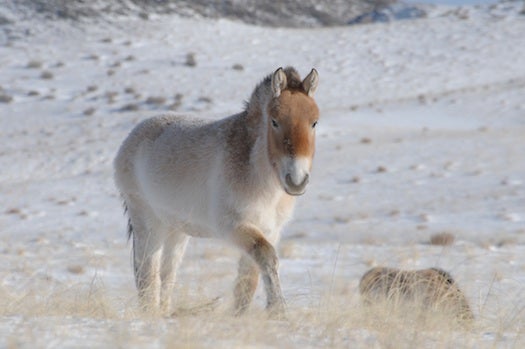Scientists Decode DNA Of 700,000-Year-Old Horse
The oldest sequenced genome will help researchers understand horse evolution.

So scientists have decoded the genome of a 700,000-year-old horse. It wasn’t enough to figure out exactly what the horse looked like—hair color, for example, will have to wait for further analysis—but it helped the researchers come up with several new ideas about horse evolution.
The feat pushes back the record for the oldest sequenced genome nearly tenfold. Before this, the oldest sequenced genome came from a hominid called a Denisovan, which lived 80,000 years ago. The techniques the horse researchers developed may help other teams sequence other ancient creatures. From what they saw in their horse, discovered in the permafrost in the Canadian Arctic, the researchers think that short bits of DNA could survive for more than a million years in the ground.

700,000-Year-Old Fossil Pieces
So what do you do with the DNA of a Middle Pleistocene horse? The research team, including biologists from all around the world, compared their horse’s genes with the genes of a variety of other horses, looking for differences that would offer clues as to when different families of horses split from each other and what genes were important to horse evolution. The other beasts that got the full-genome treatment were a 43,000-year-old horse fossil, a modern donkey, five modern domestic horses and one Przewalski’s horse, a modern animal native to Mongolia that’s believed to be the last truly wild horse species. From these comparisons, the biologists found:
- The Equus genus, which includes all modern horses, zebras and donkeys, first evolved 4.0 to 4.5 million years ago. That’s about twice as old as the oldest Equus common ancestor fossil that’s ever been found.
- Horse populations changed a lot with climactic changes over the past 2 million years. “Basically, when it’s really cold, it’s good to be a horse,” one of the lead scientists, Eske Willerslev, said during a press conference recorded in Sweden. “When it’s warm, it’s pretty bad.” Willerslev is a geneticist with the Natural History Museum of Denmark.
- The Przewalski’s horse really is a wild species; it hasn’t interbred with domestic horse.
- The genes for smelling and the immune system seemed to be especially important for horses’ survival over generations.
The researchers couldn’t determine more about their horse’s looks because their genome sequence is essentially a rough draft. On average, any one base in the genome was read just 1.12 times. Scientists like that number to be higher, to make sure the read is correct and that all bases get read. Researchers would need more time to read the horse’s genome to uncover traits such as coloring, Willerslev said. Meanwhile, researcher Ludovic Orlando, also from the Natural History Museum of Denmark, said their specimen was the size of an Arabian horse today. And it had some Y chromosome markers, so it was a male.
Orlando, Willerslev and their colleagues published their work today in the journal Nature.